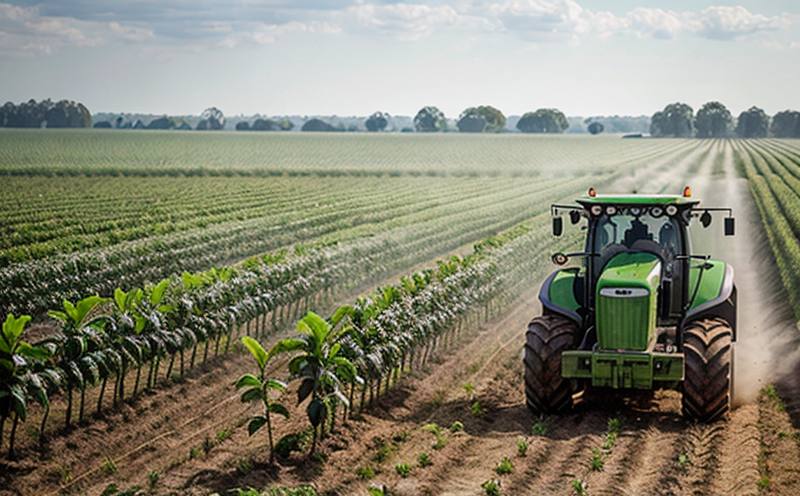IEC 62321 Hazardous Substance Testing in Agricultural Packaging
The IEC 62321 standard is a globally recognized guideline that ensures agricultural packaging complies with hazardous substance regulations. This standard addresses the potential risks of harmful substances from agricultural packaging, particularly those used in direct contact with food and other sensitive products. Compliance with this standard not only protects consumer health but also enhances brand reputation by demonstrating commitment to safety.
The test procedure involves multiple stages that ensure thorough examination. Specimens are subjected to rigorous chemical analysis aimed at detecting the presence of hazardous substances such as lead, mercury, cadmium, chromium, and other heavy metals. This is crucial for packaging used in agricultural settings where direct contact with foodstuffs can occur.
One of the primary challenges in conducting these tests lies in the variability of materials used in manufacturing. Different types of plastics, metals, or composites may have varying levels of impurities that could be harmful if not controlled. Our expertise ensures accurate and consistent testing results by adhering strictly to international standards like ISO 17025 for quality management systems.
Our laboratory employs state-of-the-art analytical equipment capable of detecting trace amounts of hazardous substances down to parts per million (ppm) levels. This precision is essential given the stringent requirements set forth by IEC 62321. Proper sample preparation plays a significant role in obtaining reliable results; therefore, we follow standardized procedures outlined in the standard itself.
The testing process typically consists of several steps: initial screening to identify suspected substances, extraction methods tailored to specific packaging types, and finally definitive identification using advanced spectroscopy techniques such as ICP-MS or XRF. Each step is meticulously documented for traceability purposes.
Compliance with IEC 62321 goes beyond mere adherence to regulatory requirements; it represents a commitment to sustainable practices within the agricultural sector. By ensuring that packaging materials do not leach harmful substances into food products, we contribute positively towards environmental protection and public health.
Our team of experienced chemists and engineers works closely with clients throughout every phase of this testing process—from consultation on best practices for sample collection to final interpretation of results. This collaborative approach helps businesses stay ahead of changing regulations while maintaining a competitive edge in the market.
Why It Matters
The importance of IEC 62321 hazardous substance testing cannot be overstated, especially for agricultural packaging which comes into direct contact with food and other sensitive products. Non-compliance can lead to significant legal repercussions including fines, product recalls, and damage to brand reputation.
- Legal Compliance: Ensures adherence to international standards such as IEC 62321, reducing the risk of non-conformity penalties.
- Risk Management: Identifies potential hazards early in the manufacturing process, mitigating risks associated with harmful substances.
- Consumer Protection: Guarantees that consumers are not exposed to potentially dangerous materials when using agricultural packaging.
In today’s highly regulated environment, companies must prioritize safety and quality assurance. By incorporating IEC 62321 testing into their quality control protocols, businesses can enhance their competitiveness while maintaining a strong ethical stance towards product integrity.
Competitive Advantage and Market Impact
Compliance with IEC 62321 provides significant competitive advantages in the agricultural packaging industry. Not only does it ensure safety but also establishes trust among consumers who value transparency regarding the materials used in food contact applications.
- Enhanced Reputation: Demonstrates a commitment to quality and consumer protection, thereby enhancing brand reputation.
- Increased Market Access: Helps companies expand into new markets where stringent regulatory requirements are enforced.
- Premium Pricing: Consumers often associate premium products with higher standards of safety; thus, compliant packaging can command higher prices in the market.
In an increasingly globalized economy, adhering to international standards like IEC 62321 is crucial for maintaining a competitive edge. It allows businesses to meet diverse regulatory requirements across different countries without having to adjust their operations multiple times.
Moreover, by proactively addressing potential hazards through thorough testing and continuous improvement efforts, companies can avoid costly recalls and other disruptions that could negatively impact profitability. This proactive approach also fosters long-term relationships with customers who appreciate responsible corporate behavior.
Use Cases and Application Examples
The application of IEC 62321 hazardous substance testing in agricultural packaging spans various scenarios, from raw material procurement to finished product release. Here are some specific instances where this standard comes into play:
- Purchase Order Verification: Before accepting a shipment, buyers verify that the packaging meets IEC 62321 requirements.
- R&D Projects: Researchers use these tests during development phases to ensure new designs comply with all relevant standards.
- Supplier Audits: Companies audit their suppliers’ facilities and processes to confirm compliance with IEC 62321 before placing orders.
- Quality Assurance: Regular testing ensures ongoing adherence to established quality parameters throughout production cycles.
These use cases underscore the importance of integrating IEC 62321 into your overall supply chain management strategy. By doing so, you can minimize risks associated with non-compliant materials while maximizing operational efficiency and profitability.





